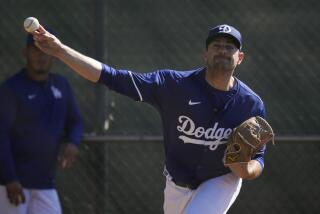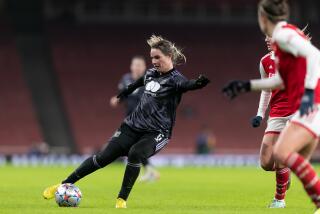Strangely, Henry Doesn’t Think He’s in a Vicious Cycle
- Share via
If Doug Henry never went near the motocross course in Budds Creek, Md., again, no one would blame him.
In 1995, the rider from Connecticut crash-landed after flying off a steep hill and broke his back.
In 1997, on Father’s Day, Henry’s bike stalled going over a double jump and this time he broke both arms.
“I’ve got to win there this year, to put all the bad thoughts behind me,” he insisted during a lull in training for the opening of the 1998 Supercross season next Saturday night in the Coliseum. “I know I can do it. I’ve just got to.”
Henry came back from his broken back to win last year’s second Supercross in the Coliseum, and he came back from his broken arms to win the season finale at Las Vegas.
“We all recognize Doug’s strength and dedication, we just wish he would quit proving it,” said former national champion David Bailey, now an ESPN commentator.
Henry, 28, says the first crash was his fault, the second one the bike’s fault. This year, he says, he expects both himself and his Yamaha to perform correctly.
How the 1995 crash happened:
“I had just won my first 250cc outdoor national for Honda the week before at Mt. Morris [Pa.], and I was anxious to win two in a row. There were two laps to go and I was running second, maybe three or four seconds back of Mike LaRocco, and just ahead of Jeremy [McGrath] when I made a little mistake on a double jump, which was followed by a downhill.
“I tried to make up for the time I’d lost by accelerating down the hill. It was a mistake. The bike bottomed out and in trying to just hang on, I kept the throttle on going up a steep hill. Instead of braking for the jump, I was wide open.
“When I got airborne, I knew I was in serious trouble. I was way, way too high. I had two choices, to bail off the bike in midair, or try and ride it out. I decided to stay on.
“It was a strange feeling, floating up there. Have you ever had a dream where you were falling out of bed, or off a building, and you woke up just before you hit? Well, that’s how I felt. I felt like I was in a dream, that I would wake up and everything would be OK.
“It turned out to be a nightmare, a real-life one. I landed the bike perfect, but when it hit, my arms and legs couldn’t support me. My butt slammed down so hard [on the seat] it snapped the L1 [first lumbar] vertebra. I never lost consciousness, and my first reaction was to see if my arms and legs moved. When I realized I wasn’t paralyzed, my thoughts were to get back to the truck and get ready for the next moto.
“Then I felt a sharp pain in my back and I just lay there.”
Emergency workers rushed to his side, carefully loading him on a stretcher to be airlifted to a local hospital.
But the prognosis of a broken back was bleak, especially when doctors in the emergency room told Henry that they would need to fuse six vertebrae, which would have ended his racing career.
“I told them I didn’t believe them, and when my wife [Stacey] didn’t believe them, either, she found an AMA doctor who recommended I be moved to the George Washington University Hospital in D.C. Without Stacey’s insistence that something more be done, I probably would have ended up with fused vertebrae. I owe my second career to her and Dr. Tom Malone, the AMA doctor who got me to the right specialists.”
Instead of fusing the vertebrae, the D.C. physicians cut Henry open from his back, around his side and clear across his stomach in order to clean out the minute pieces of his shattered lumbar.
“I’ve got the scar to prove it,” he says.
The physicians built a tiny titanium cage, which they filled with the broken pieces, plus some bone from his hip, then spread the spine apart and put the cage where the L1 vertebra once was. Three screws keep it in place.
“Once I had my back repaired, I knew I would ride again. It was just a matter of time. I set a goal for myself to race again in March [1996]. I beat my goal, my first race was Feb. 24 in Atlanta, but it was tough going, tough to keep from getting discouraged.”
While undergoing rehabilitation, Henry and his father built a practice Supercross track on seven acres Doug had purchased next to his home in Oxford, Conn.
“I was thinking one day, what an irony it was to have my dad out there, after seeing his son suffer a broken back in a race, helping him build a track so he could get back on a bike and risk doing it again.”
Henry missed the first five races in 1996 and when he returned, he had left Honda and joined the Yamaha factory team.
“I think one of my biggest thrills was just being there that night in Atlanta. I was so excited to be back racing with the guys. I finished 14th, but that didn’t matter. I was back. But after the excitement wore off, things didn’t go well. I was so far behind [in training], I had a real tough year. When I couldn’t seem to catch up, I seriously thought about giving it up. Every week, it hurt more. Not my back, but mentally.
“Toward the end of the year, I finally won a moto in Washougal, Wash., and that gave me the lift I needed to prepare for 1997.”
Henry came out fast last season, finishing second to Greg Albertyn in the first of two Coliseum main events and then winning the second. A week later, at Tempe, Ariz., he won again and was leading in points when he broke his hand at Houston on March 22 and missed the next five events.
Once again, he showed remarkable recuperative qualities by returning to the outdoor motocross series in May.
Then came Budds Creek II. Henry tells how it happened:
“I was just cruising along when I came to a big double jump, nothing special about it, but just as I was about to launch, the engine locked up and cut off. I came up short, nose-diving into the bank.
“I’m not sure if it was the impact of my hands on the handlebars when I hit, or when I hit the ground after I was tossed off, but I know it hurt bad. Both of my arms were snapped just above the wrists.”
One of TV’s poignant moments shows Henry, his hands dangling from his forearms, having his helmet removed by a bystander. This time, Stacey and the track doctor decided immediately to take him to the same hospital where his back had been repaired.
“They didn’t think I needed to be airlifted, so we headed off in an ambulance. It should have been about a hour’s ride, only the ambulance driver got lost. My fingers were real black and real cold and I think I almost passed out when I heard that the driver didn’t know the way. Fortunately, Stacey was along and she remembered enough from the time before that she got us there.”
Two months later, with plates in his wrists, Henry was back racing and in the last race of the season, aboard a controversial four-stroke Yamaha, he won at Las Vegas. It was the first time a four-stroke engine--about 40 pounds heavier than the two-strokes--had ever as much as qualified for a main event.
“When Yamaha asked me about helping develop a production four-stroke machine, I was all against it,” Henry said. “I had gone through one tough year in ’96 and I didn’t want another one, but my family and my friends said they thought it would be neat if I could make a winner out it.
“For a while, I thought it was hopeless, but the Thursday night before Las Vegas, my tuner [Pete Steinbrecher] and I worked six hours in the parking lot, after the track closed, getting the carburetor working right. I was pretty pleased when I finally went to bed.
“On Friday, practice went good. On Saturday, getting ready for the race, I felt comfortable with the engine for the first time. In my heat race, I got a hole shot and beat [national champion] Jeff Emig. That did wonders for my confidence and I felt if I could come out and make a clean start in the main event, I’d have a chance.”
It worked just as he’d planned. Henry was a wire-to-wire winner.
“Now I’m looking forward to racing the four-stroke all season. I’m also looking forward to 1998 because Stacey and I have a new 38-foot motor home that we’re going to drive from race to race and see as much of the country as we can.”
Traveling with the Henrys will be daughter Brianna, 1 1/2, two dogs and a cat.
“It sounds like we might be crowded, but when I was just starting out as a privateer, Stacey and I were living in a box van with my cycle and all my equipment. If we survived that, living in a motor home should be a piece of cake.”
More to Read
Go beyond the scoreboard
Get the latest on L.A.'s teams in the daily Sports Report newsletter.
You may occasionally receive promotional content from the Los Angeles Times.










